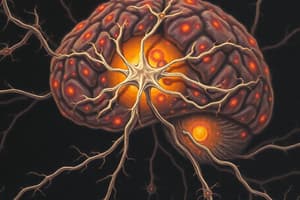Podcast
Questions and Answers
What are the three parts of a neuron?
What are the three parts of a neuron?
Cell Body, Dendrites, Axon
What is the primary function of glial cells?
What is the primary function of glial cells?
- Support neurons (correct)
- Conduct action potentials
- Generate electrical signals
- Transmit signals
The fatty, protective wrapping around axons of some neurons is called _____.
The fatty, protective wrapping around axons of some neurons is called _____.
myelin sheath
Gray matter consists of bundles of parallel axons with their myelin sheaths.
Gray matter consists of bundles of parallel axons with their myelin sheaths.
What is the role of Nodes of Ranvier?
What is the role of Nodes of Ranvier?
Where is the cortex located?
Where is the cortex located?
What establishes the resting membrane potential?
What establishes the resting membrane potential?
Nerves consist of bundles of neuron cell bodies located in the CNS.
Nerves consist of bundles of neuron cell bodies located in the CNS.
Study Notes
Cells of the Nervous System
-
Neurons/Nerve Cells: Fundamental units for receiving stimuli, conducting action potentials, and transmitting signals. Composed of three key parts:
- Cell Body: Houses the nucleus; processes incoming stimuli.
- Dendrites: Branched extensions that receive signals from other neurons or sensory receptors.
- Axon: A singular elongated structure responsible for transmitting signals to glands, muscles, organs, or other neurons.
-
Glial Cells/Neuroglia: Supportive cells in the Central Nervous System (CNS) and Peripheral Nervous System (PNS); do not conduct action potentials but perform various functions that bolster neuron activity and maintain homeostasis.
Types of Neurons & Glial Cells
- Myelin Sheaths: Protective fatty layer surrounding the axons of certain neurons, produced by oligodendrocytes in the CNS and Schwann cells in the PNS. They act as effective insulators, preventing ion movement across the membrane.
- Nodes of Ranvier: Intervals between myelin sheaths where ion exchange occurs, facilitating the development and propagation of action potentials.
Organization of Nervous Tissue
-
Gray Matter: Composed of clusters of neuron cell bodies and their dendrites, characterized by low myelin content:
- Cortex: Surface layer of the brain.
- Nuclei: Deeper clusters of gray matter within the brain.
- Ganglion: Group of neuron cell bodies situated in the PNS.
-
White Matter: Comprises bundles of myelinated axons, appearing whitish:
- Nerve Tracts/Conduction Pathways: Bundles in the CNS that relay action potentials between different CNS regions.
- Nerves: Collections of axons within the PNS.
Electrical Signals of Nervous System
- Involves mechanisms such as resting membrane potential, action potentials, synapses, and reflex arcs.
Resting Membrane Potential
- Represents the equilibrium state wherein the concentration gradient of potassium ions (K+K^+K+) driving them out of the cell is countered by the intracellular negative charge that draws them back. This potential is primarily maintained by:
- Elevated concentrations of K+K^+K+ inside the cell membrane.
Studying That Suits You
Use AI to generate personalized quizzes and flashcards to suit your learning preferences.
Description
Explore the fundamental components of the nervous system in this quiz focused on neurons and glial cells. Understand the structure and function of these critical cells, including their roles in transmitting signals and supporting neuronal health. Test your knowledge of neurons' anatomy and their functions.





